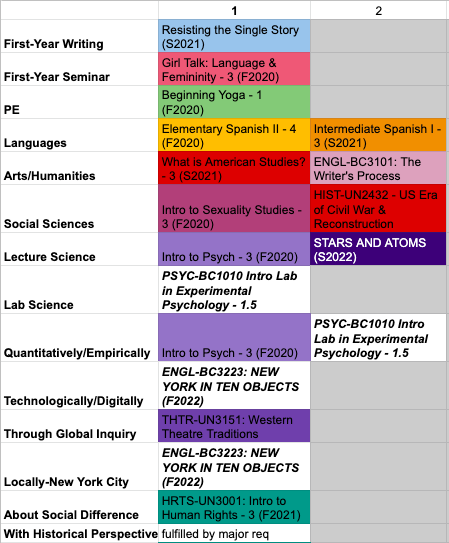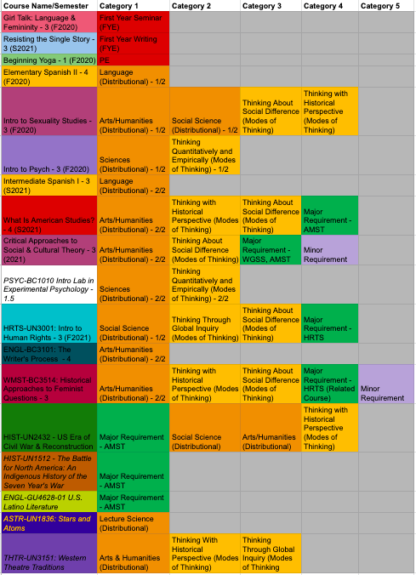Barnard’s DIY approach to the core can be overwhelming, but lucky for you, Bwog is here to help you plan with the best strategies for knocking out every Foundations requirement.
Understanding Barnard Foundations
“Foundations” is an umbrella term used by Barnard to refer to all of its extensive graduation requirements. While Barnard’s Foundations requirements are somewhat loose compared to the Columbia Core, there are still a lot of requirements to fulfill. They fall into three general categories: First Year Experience, Distributional Requirements, and Modes of Thinking.
As the name implies, during your first year, you’ll be required to complete three First Year Experience courses: First Year Seminar, First Year Writing, and one PE course. In general, the remaining Foundations Requirements can be taken at any point throughout your time at Barnard.
However, your first year is a great time to fulfill some additional Foundations requirements! Barnard’s curriculum is designed so that students can wait until the spring of their second year to officially declare a major, so many students find the best strategy for fulfilling all graduation requirements is to focus more heavily on fulfilling the Foundations during their first two years, then shifting focus to their major in later years. That said, don’t worry too much about knocking out every requirement in your first two years! Keep in mind that you’ll have time to continue filling those requirements during later years—even if your schedule is mostly concentrated in your major department—and that sometimes, classes within your major will also fulfill Foundations requirements. One great thing about Barnard’s curriculum is that the Foundations requirements are incredibly flexible, meaning you can focus on finding what fields and departments interest you and undoubtedly fulfill a ton of requirements along the way. Before you get started, let’s break down some of the most helpful strategies for knocking out those requirements.
Don’t be afraid to experiment.
Barnard’s graduation requirements are designed the way they are for a reason—you don’t have to declare your major until the spring of your second year, so until then, why not take a little extra time to explore some new interests, and knock out Foundations requirements along the way? As Barnard students across academic fields can attest, it helps to power through the requirements outside your academic wheelhouse as early as possible. If you’re a proud Humanities girlie, try finding something that fulfills the more STEM-oriented requirements, like the science lectures or Thinking Technologically and Digitally. If you’re more of a STEM person, try something that fulfills Arts & Humanities requirement! Worst case scenario, you’ll end up disliking the class, but will still have gotten the graduation requirement out of the way so you have more time to focus on your interests throughout the rest of your time here. Best case scenario, you find yourself loving the classes, and realize you’ve stumbled upon a new academic interest!
That being said, you know yourself best.
One of the great things about Barnard’s Foundations is that there are at least ten ways to fulfill each requirement. Between the University’s extensive catalog, the double-dipping option, and the diverse array of courses that count for each requirement, it’s not hard to tailor your schedule to the classes and departments that most interest you.
If you’re a Humanities major with zero interest in STEM, try pairing the Introduction to Psychology lecture with the Introduction to Experimental Psychology lab! While the lab is in high demand and can be hard to get into, it’s definitely worth waitlisting. This pair of courses is designed explicitly for non-STEM majors looking to fulfill their science class requirements, and can even help you meet three Foundations requirements simultaneously. The lecture will fulfill one of your two Science Lecture course requirements, the Lab fulfills the Science Lab requirement, and when taken together, the two courses also fulfill the Thinking Quantitatively and Empirically requirement.
Take advantage of double-dipping!
Barnard has what’s known as a “double-dipping” policy, meaning any given course can fulfill up to two graduation requirements for each student. This means that not only is it possible to fulfill two Foundations requirements with one course, but it’s even possible—and common—to fulfill a Foundations requirement with a course that is also required for your major. For example, a science Lab course that’s required for your major can also be used to fulfill the Distributional Lab Science requirement. Just beware—while it’s perfectly okay to double-dip courses, it’s not possible to triple-dip, meaning even if a course can technically fulfill more than two requirements, you can only use it to fulfill two.
Let’s look at another example: Critical Approaches to Social and Cultural Theory is an intro-level course in the Women’s, Gender, and Sexuality Studies department, and a required course for students pursuing that major. However, it can also be used to fulfill the Thinking About Social Difference requirement, and as one of the two required Arts & Humanities courses. This means if you take the course as a non-major, you can use it to fulfill two Foundations requirements at once. However, if you decide to major in Women’s, Gender, and Sexuality Studies, you can use this course to satisfy your major requirement, and still use it so satisfy one of the two aforementioned Foundations requirements (you just can’t use it to satisfy all three requirements).
Take time to plan things out.
There is absolutely nothing wrong with starting your first year having no idea which major you’ll choose. As we’ve already said, Barnard’s Foundations provides a great opportunity to explore a variety of fields and help discover new interests. However, if you’re already interested in certain departments, looking into which of their course offerings also fulfill Foundations requirements can be a great planning strategy. Not only is it a great way to test the waters in a potential academic interest, but thanks to Barnard’s double-dipping policy, it could end up helping you knock out major requirements early. Barnard keeps a helpful list of which courses have fulfilled each Foundations requirement in past years, so if you can find a class you’re interested on the list, this is a great resource.
On that note, do everything you can to stay organized.
If you don’t already have a spreadsheet to track your Foundations requirements as you complete them, start one now. Seriously—finish this article and open a sheet immediately. Yes, Student Planning offers a degree audit that “tracks your Foundations requirements,” but it’s difficult to read and almost always has at least one error. Take your education into your own hands today. Personally, I like to use one sheet to chart every course I take and record exactly which Foundations requirements they fulfill, then use a second sheet to track my own progress, filling in each requirement with the course I’ve taken to satisfy it. As you’ll soon find, the more courses you take, the more ways there are to configure them into satisfying different requirements, so this strategy lets me know exactly what I’ve already completed and what I still need to complete.


Go easy on yourself, and try to have fun with it!
While it’s a great strategy to get the less interesting requirements out of the way first, there’s also nothing wrong with easing into the curriculum by starting with a few courses that interest you the most. Here, Bwog’s Barnard Seniors™ advocate balancing your schedule—take the courses that interest you, but try to challenge yourself with something new (and preferably, something that fulfills a Foundations requirement) at least once a semester.
Your Registration Resource Library
Student Planning is the platform that Barnard students use to register for all of their classes. On Student Planning, you can view available classes for the fall, and add the classes that you’re interested into your schedule. You can do this any time before your registration period starts, and once it’s time for you to register, you can register for any of the classes that you’ve added to your schedule. If a class is already full, you can join the waitlist from your schedule as well.
The CU Directory of Classes is a comprehensive list of all of the courses offered at Columbia and Barnard, organized by department. If you’re interested in a certain field, and want to see what classes are being offered for the fall, this directory is a great resource that will also allow you to view how many sections of each class are available and the days and times they are offered. Personally, I prefer using this platform to search for classes over Student Planning because I find that searching by department makes it easier to find specific classes.
SSOL (Student Services Online)
If you are on the waitlist for a class, the “Registration” tab of SSOL will allow you to view how many people are ahead of you on the list. Additionally, if you want to see if a class already has a waitlist, you can search the class under the registration tab and find out how many people have already joined the waitlist!
Vergil is another convenient course catalog from Columbia that allows you to view the course descriptions for any specific class. Vergil will also allow you to see what classes a certain instructor is teaching, and let you know if a class has any required prerequisites. If you’re on the waitlist for a certain class, Vergil will also give you access to the class’s Courseworks page.
The Barnard course catalog is the Barnard-specific list of courses offered. While this resource can be really helpful because it allows you to view the course descriptions for each course and search the titles of specific courses, most students prefer to use the CU Directory of Classes because it is generally more accurate and up-to-date, and this catalog does not show the full course offerings from Columbia.
Barnard 2022-23 Academic Calendar
Make sure that you have access to this calendar to keep track of upcoming registration periods, the start and end dates for each semester, and exam periods!
Diana Center via Bwog Archives


 1 Comments
1 Comments
1 Comment
@Anonymous This was very well done! Super helpful, thank you.
-a grateful freshman